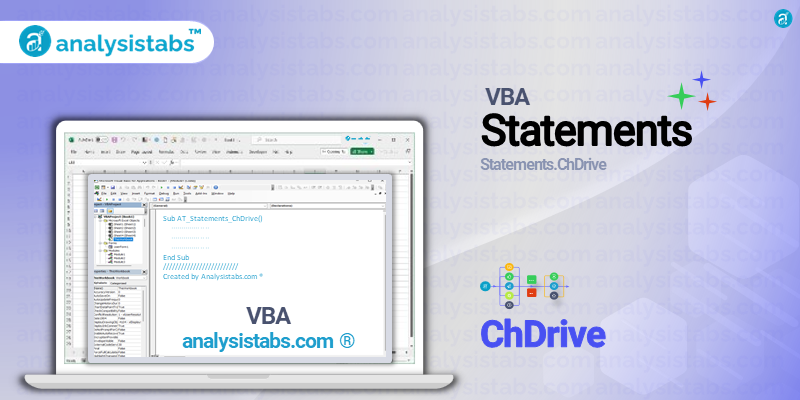The ChDrive statement plays a crucial role in manipulating and managing different drives on your computer. In this blog post, we will dive deeper into the purpose, syntax, and examples of the ChDrive statement. So, let’s get started!
VBA ChDrive Statement
The Purpose of ChDrive Statement
The ChDrive statement stands for “Change Drive” and is used to change the current drive in VBA. It is particularly useful when working with multiple drives and files on your computer, allowing you to switch between them without having to manually change the drive within the code. This can save you a lot of time and effort when working with large datasets or performing complex tasks.
Syntax of ChDrive Statement
The syntax for the ChDrive statement is as follows:
ChDrive driveletter
Where “driveletter” is the letter of the drive you want to switch to. It is important to note that the drive letter must be enclosed in double quotation marks and can be either uppercase or lowercase.
Examples of using ChDrive Statement
Now, let’s take a look at some practical examples of how the ChDrive statement can be used in different scenarios.
Example 1 – Switching to a specific drive:
Dim currentDrive As String currentDrive = "C:" ChDrive currentDrive
In this example, we are using the ChDrive statement to switch to drive “C:” by defining it as a variable. This is useful when you have a specific drive that you want to work on and need to switch to it multiple times in your code.
Example 2 – Getting the current drive:
Dim currentDrive As String currentDrive = CurDir ChDrive currentDrive
This example shows how the ChDrive statement can be used with the “CurDir” function to get the current drive and then switch to it. This is useful when you want to make sure your code is working on the correct drive at a certain point.
Example 3 – Creating a new folder on a different drive:
Dim currentDrive As String Dim newFolder As String currentDrive = "D:" ChDrive currentDrive newFolder = "NewFolder" MkDir newFolder
Here, we are using the ChDrive statement to switch to drive “D:” and then creating a new folder called “NewFolder”. This is useful when you need to create folders or files on a specific drive rather than the current drive.
Example 4 – Copying files to a different drive:
Dim currentDrive As String Dim destinationDrive As String Dim fileName As String currentDrive = "C:" destinationDrive = "D:" fileName = "Example.xlsx" ChDrive currentDrive FileCopy fileName, destinationDrive & fileName
Here, we are using the ChDrive statement to switch to the current drive where the file “Example.xlsx” is located, and then copying it to drive “D:”. This is useful when you need to copy files from one drive to another in your VBA code.
Example 5 – Looping through multiple drives:
Dim currentDrive As String
Dim driveList As Variant
driveList = Array("C:", "D:", "E:", "F:")
For Each currentDrive In driveList
ChDrive currentDrive
'perform some tasks
Next currentDrive
In this example, we are using the ChDrive statement in a loop to iterate through multiple drives and perform some tasks on each of them. This is useful when you need to work on a set of drives and don’t want to write repetitive code.
Important Notes & Remarks
It is important to note that the ChDrive statement only works with local drives, not network drives. Also, if the drive letter specified does not exist or is not accessible, the ChDrive statement will generate a runtime error. Therefore, it is recommended to always use error handling when working with the ChDrive statement.
In this blog post, we have explored the purpose, syntax, and top 5 examples of the ChDrive statement in VBA. We have seen how this statement can be used to efficiently manage and manipulate drives in your coding tasks. As with any programming language, understanding and utilizing different statements like ChDrive can greatly improve your productivity and make your code more efficient. So, the next time you are working with multiple drives in VBA, make sure to give the ChDrive statement a try and see the difference it can make!
Thank you for reading my blog post on the ChDrive statement in VBA. I hope you found it informative and helpful. I would love to hear your feedback and views on this topic. Have you used the ChDrive statement in your VBA projects? What was your experience like? Did you face any challenges or find any other interesting use cases for this statement? Please feel free to share your thoughts in the comments section below. Your valuable feedback will help me improve and provide better content in the future. Thank you!





